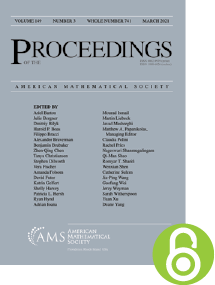Topological classification of irreducible plane curve singularities in terms of Weierstrass polynomials
HTML articles powered by AMS MathViewer
- by Chunghyuk Kang PDF
- Proc. Amer. Math. Soc. 123 (1995), 1363-1371 Request permission
Abstract:
Let $f(z,y)$ be analytically irreducible at 0 and $f(0) = 0$. Then the plane curve singularity defined by f has the same topological type as the curve defined by ${f_{k + 1}}$ for some $k \geq 0$ where ${f_1} = {z^a} + {y^b},{f_2} = {f_1}^{{n_{21}}} + {y^{{m_{11}}}}{z^{{m_{12}}}},{f_3} = {f_2}^{{n_{31}}} + {f_1}^{{n_{22}}}{y^{{m_{21}}}}{z^{{m_{22}}}}, \ldots$ are defined by induction on k with distinct numerical conditions topologically invariant. Moreover, we give an easy alternate proof of Zariski’s topological classification theorem of irreducible plane curve singularities.References
- Oscar Zariski, Studies in equisingularity. I. Equivalent singularities of plane algebroid curves, Amer. J. Math. 87 (1965), 507–536. MR 177985, DOI 10.2307/2373019
- Oscar Zariski, Studies in equisingularity. III. Saturation of local rings and equisingularity, Amer. J. Math. 90 (1968), 961–1023. MR 237493, DOI 10.2307/2373492
- Henry B. Laufer, Normal two-dimensional singularities, Annals of Mathematics Studies, No. 71, Princeton University Press, Princeton, N.J.; University of Tokyo Press, Tokyo, 1971. MR 0320365
- Tom M. Apostol, Introduction to analytic number theory, Undergraduate Texts in Mathematics, Springer-Verlag, New York-Heidelberg, 1976. MR 0434929
Additional Information
- © Copyright 1995 American Mathematical Society
- Journal: Proc. Amer. Math. Soc. 123 (1995), 1363-1371
- MSC: Primary 14H20; Secondary 14B05
- DOI: https://doi.org/10.1090/S0002-9939-1995-1291777-2
- MathSciNet review: 1291777


